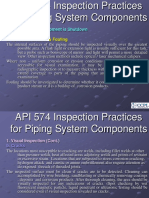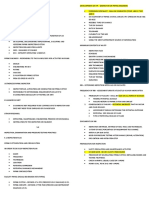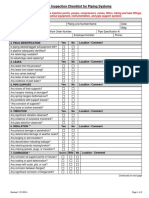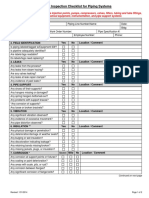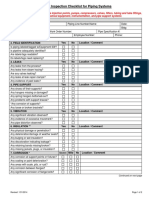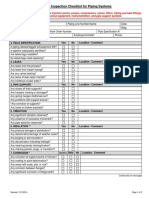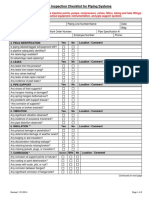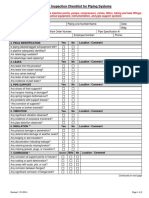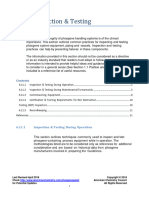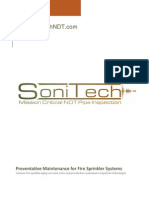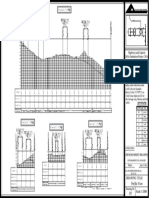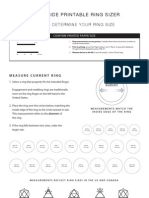FACILITY FIRE SAFETY SYSTEM INSPECTION
FACILITY FIRE SAFETY SYSTEM INSPECTION
Submitted By
Bibek singh
Imran Khan
�NFPA Clause What to Do (Inspection What to Look for /
Requirement Action) Where to Look
5.2.2.1 Pipe and Fittings Visual inspection (direct Search for indentations
Free from Mechanical or indirectly via aids likebruise that is cut, bent,
Damage, Leakage, and flashlight, binoculars, scarred, scuffed. Check
Corrosion. ladder) for mechanical pipes and fittings whether
damage they have distortion due
to an impact, pressure or
handling.
5.2.2.2 Sprinkler Pipe Checking for external search for some cables,
Not to Be Subjected to loads or stress on pipes signs or anything else
External Loads (look for anything resting that can be hung or
. on pipes or hanging from placed on the pipes and
them) create additional stress
5.2.3.1 Hangers, Braces, Inspection the hangers, Especially search for
and Supports Must Be braces, and supports those parts of the system
Secure and Undamaged (from the ground or with that may be delaminated,
aids if necessary) rotten or detached which
may influence the
stability of the system or
the location of the pipes
and sprinklers.
5.2.2.1 Corrosion - Corrosion check by Examine issues to do
Identification and visual assessment, assess with the length of the
Prevention whether the coatings are exposed pipe, joints,
Visual inspection for deteriorating or worn out fittings, and sprinkler
corrosion, check if any heads.
coatings are damaged or
showing signs of wear.
Corrosion of Pipe and Direct Visual Inspection: Check exposed pipes,
Fittings (NFPA 25 Using flashlight, ladder, joints, fittings, and
5.2.2.1) or binoculars as sprinkler heads for signs
necessary. Check both of rust or wear.
exposed and easily
accessible parts of the
system.
Galvanic Corrosion Visual Inspection at Look for localized
Metal Joints: Focusing corrosion at metal
on areas where dissimilar junctions (e.g., copper
2|Page
� metals meet. and steel pipes). Signs
include rust, excessive
wear, or damaged metal
at the point where metals
connect.
General Corrosion . Direct Visual Inspection: Looking for uniform
. Checking exposed piping thinning of the pipe
and fittings in accessible material, rust, or
areas discoloration across the
surface. This will
typically be evenly
spread along a section of
pipe or fitting
Pitting Corrosion Visual Inspection & Looking for small, deep
. Touch: Use flashlight and holes (pits) in the metal
possibly magnifying surface. These may
tools for detailed appear as small craters or
inspection. depressions, often with
surrounding rust or
discoloration
Crevice Corrosion Visual Inspection at Search for red or brown
. Joints & Fittings: Focus discolouration on pipe
on pipe joints, flanges, or joints, flanges or the
areas where moisture lower side of fittings
may accumulate, such as where water settles.
gaskets. These regions are
considered more delicate
to localized corrosion
Filiform Corrosion Visual Inspection on In most cases, we may
Coated Pipes: Check notice threadlike, pointed
pipes that are painted or or elongated blister or
have a protective coating. bubble type formation
under the coating or paint
layer. This is also a form
of surface corrosion that
causes straight fine lines
or patterns to be formed
beneath
Microbiologically Visual & Touch The signs of
Influenced Corrosion Inspection in Damp condensation include
3|Page
�(MIC) . Areas: Inspect areas slimy or dark coloured
prone to biofilm buildup, streaks along the Pipe or
such as near joints or in fittings or microbial
stagnant water zones. growth is usually
attached to the pipe or
any fittings. (biofilm).
Discoloration may appear
localized around areas
with poor drainage or
stagnant water
Stress Corrosion Focus on areas that are Visual Inspection at
Cracking (SCC) under mechanical stress, Stress PointsLook for
such as pipe supports, long, narrow cracks
joints, or bends. along the surface of the
pipe, especially near
joints, welds, or stress-
bearing points (e.g., pipe
supports). Cracking is
often associated with
physical tension and
exposure to corrosive
environments.
Intergranular Corrosion Welded Joints: Inspect The regular check must
. welded areas, particularly be done on instant
heat-affected zones crackles or discoloration
on the object at weld
points or along regions
with thermal affect. This
kind of corrosion takes
place at grain boundaries
of the metal and can lead
to cracks or brittle zones
Erosion Corrosion Visual & Touch Peaks of exposed pipe
. Inspection of Internal outer or inner walls, signs
Surfaces: Focus on areas of chemical or
with high fluid flow, such mechanical wear inside
as pipe bends, elbows, or pipes in the zones of
valves. increased flow velocity
can be good starting
points. These areas may
4|Page
� lack rough feeling on the
tongue, shiny, or
polished in appearance
suggesting erosion from
fluid movement
Leakage (5.2.2.1 – Pipe Look for signs of Wet spots on the floor,
Leaks) leakage, directly or walls, or around pipe
indirectly, with aids connections. Water stains
on fittings, or visible
drips from joints or pipe
sections. Check for signs
of rust or corrosion near
leaks.
Obstruction Investigation Perform obstruction Worry whether there are
for Sprinklers (Article 2) inspection by visually any obstructions to the
checking sprinklers and sprinkler head and seek
pipe system, using flow signs of either low flow
tests and water pressure or pressure. Search for
gauges dust, dirt, paint
accumulation on the
sprinkler heads. Insight
based tests, to verify that
water is free to pass
through pipes without
restrains.
Obstruction Causes Examine areas with Physical obstructions like
potential blockage (near storage, debris, or paint.
sprinkler heads or pipe Corrosion or scaling in
connections) pipes can also obstruct
water flow. Be aware of
any environmental
factors like humidity,
temperature changes, or
building materials that
could affect system
operation.
5|Page
